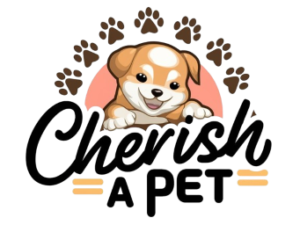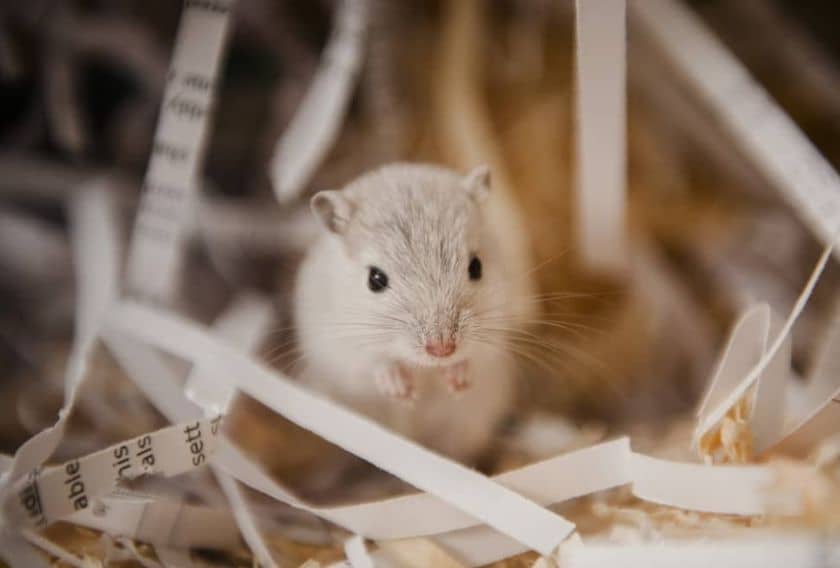Degu is a small rodent with a bubbly personality native to Chile. It is a rat-like species but larger than a hamster and smaller than a fancy rat. A large head, large eyes, dark sparsely furred ears, pale grey toes, and a long thin tail with a tufted black tip characterize the Degu.
The Degu has a body length of nearly 25- 31cm (9.8-12.2”) with a weight ranging between 170g-400g(6- 14.10Oz). The life span of Degu is nearly 6-8 years in captivity but it can be longer with proper care and handling.
The Degu is found in various colors of yellow, brown, golden, silver, and grey. The color of the fur has a different shade around the neck and areas near the eyes.

Their scientific name is Ocodon Degus, with a common name as Degu. It has got this name as its molar and premolars are similar to the shape of the numeral 8.
They belong to the Octodontidae family, which also includes chinchillas and viscachas. Known for their social nature and high intelligence, degus make delightful pets for those willing to dedicate time and effort to their care.
The Degus have good eyesight and can see clearly in UV light.
Degu Behavior and Temperament
The degu is a highly social creature and forms close bonds with other degus and owners. They are playful and curious fellows who need social interaction to keep themselves busy.
It is more likely that you may see some behavioral changes when these are housed alone. Therefore it is better to keep same-sex degus in the cage to nurture their social instincts. The degus have an elaborate vocal repertoire comprising up to 15 different sounds.
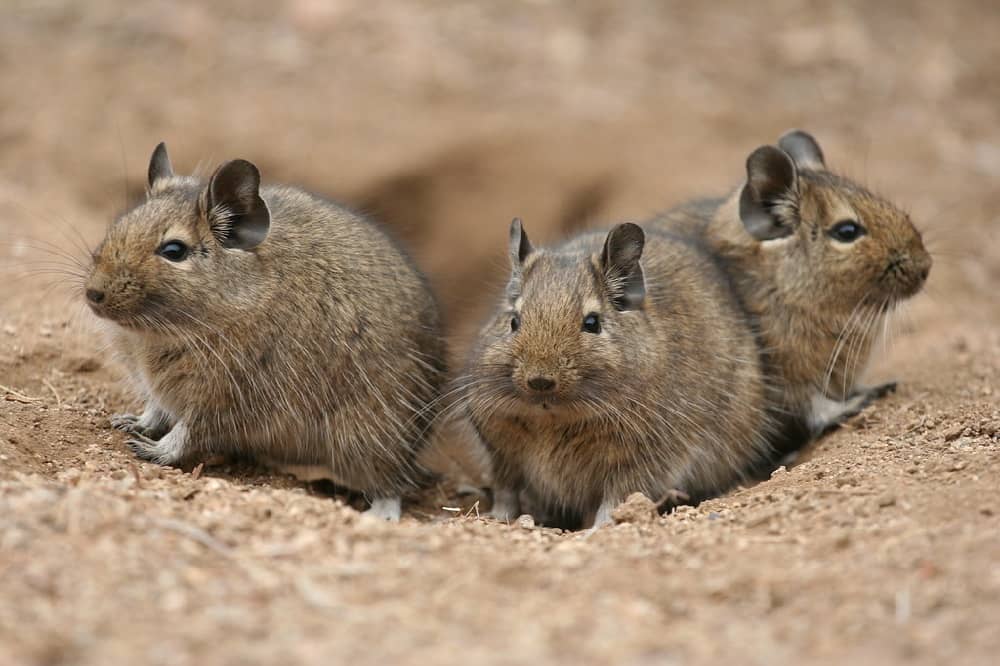
They are fearful and need time to adapt to human contact. You should start handling them early to acclimatize them for handling. They have good eye and paw coordination which is evident from their ability to stack different objects of decreasing size.
How to Care for a Pet Degu?
Providing proper care for degus involves ensuring they have a stimulating environment, a balanced diet, regular exercise, and veterinary check-ups. They thrive in a consistent routine and may become stressed by some unexpected changes in their environment.
Housing
The Degu is a gregarious and energetic creature so you should provide spacious enclosures with plenty of room for exercise and enrichment. A large wire cage with multiple levels and platforms is ideal, along with plenty of hiding spots and chew toys.

A solid roof gives them a kind of safety as they can be frightened of movements. You should also place some branches of shrubs so as to give them enough vertical space to climb.
Specific Substrate Requirements
The bedding should be deep enough to provide comfortable and cozy bedding to your degu. There are certain points to be taken care of while setting up the bedding with a particular material. Avoid using cedar or pine shavings, as they can be harmful to their respiratory systems.
Nest Box
A small nest box of size (6”x 8”x 6”) should be set within the cage of Degu. Good quality hay, shredded paper, tissue paper, paper towels, and cardboard are convenient choices to be used as nesting material in the nest box. You should not use cotton wool or similar bedding products as the strands of cotton get struck in their legs and pose a serious risk to their health.
Chew Toys
A degu has overgrowing teeth, therefore you should provide chew sticks and toys for gnawing.
Exercise Wheel and Tunnel Tube
The degu love to keep themselves busy by hopping from one point to another in their cage. You can provide an exercise wheel to roll and enjoy. They explore every corner of their cage and wander through tunnels and ladders.

Sand Bath
You must create a small bathing zone with desert sand inside the enclosure. A designated area will be less messy and easy to clean. It helps them to stimulate their natural digging behavior.
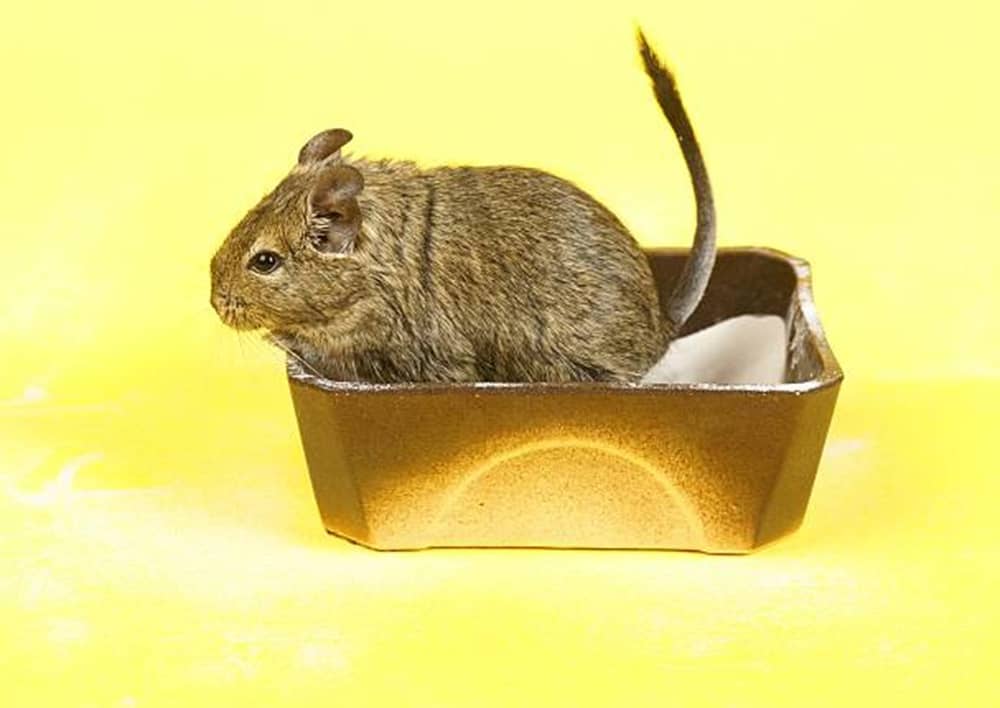
You should use a high-sided tray, big enough for your furry friend to have a good roll in. The sand should be changed regularly.
Food Bowl and Water Bottle
A ceramic food tray and a water bottle should be kept inside the enclosure. The water bottle should have a metal tube with a chew guard.
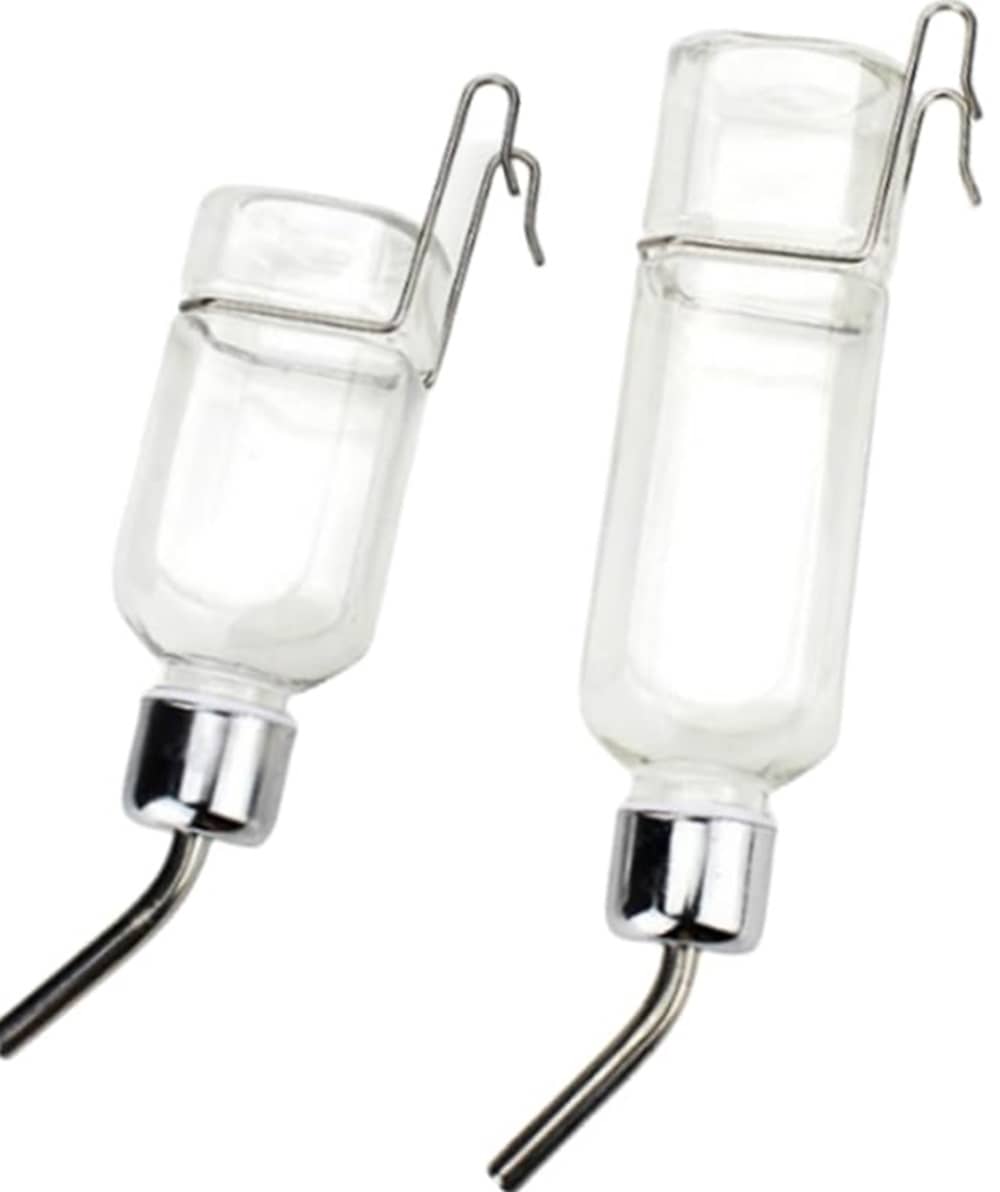
Other Points of Consideration
- The enclosure should be set nearly at waist height.
- It should be well-ventilated with a temperature range of nearly 20 degrees Celsius.
- You should regularly spot-clean the enclosure.
- After Cleaning put some used but unsoiled nesting and bedding material back into the enclosure so as to give them a familiar scent.
- You should remove any hoarded food.
- Never house them with hamsters, gerbils or guinea pigs as they are prone to get infections.
What Do Degu Eat and Drink?
A Degu is strictly a herbivore and consumes mostly grasses, leaves of shrubs, seeds, and vegetables. A balanced diet for degus consists of high-quality pellets, fresh vegetables, hay, and occasional treats such as dried fruits or nuts. It is highly susceptible to developing Diabetes mellitus, therefore you should avoid feeding them sugary or fatty foods, as these can lead to health problems.
Vegetables like dark lettuce, dandelion greens, and good-quality hay give them high-fiber and essential nutrients. Carrot, sweet potato, beetroot, and parsnips can be given as an occasional treat only.
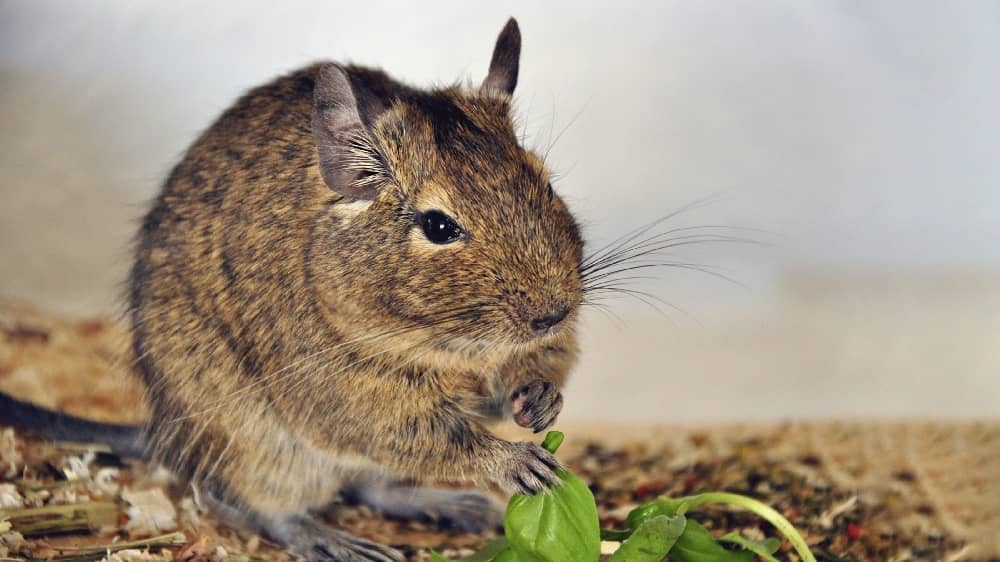
The degus also shows coprophagy or faecal reingestion just like rabbits. It helps them to get nutrients and keep their digestive system healthy.
Commercial degu nuggets can also be given occasionally. You should provide access to clean drinking water in a water bottle with a metal tube so that it is not chewed up by your degu.
Handling
Degus can be trained to tolerate handling, but they may be initially skittish. It would be better if you start training your degu for human contact by offering small treats on daily basis. This will help them to build trust in you.
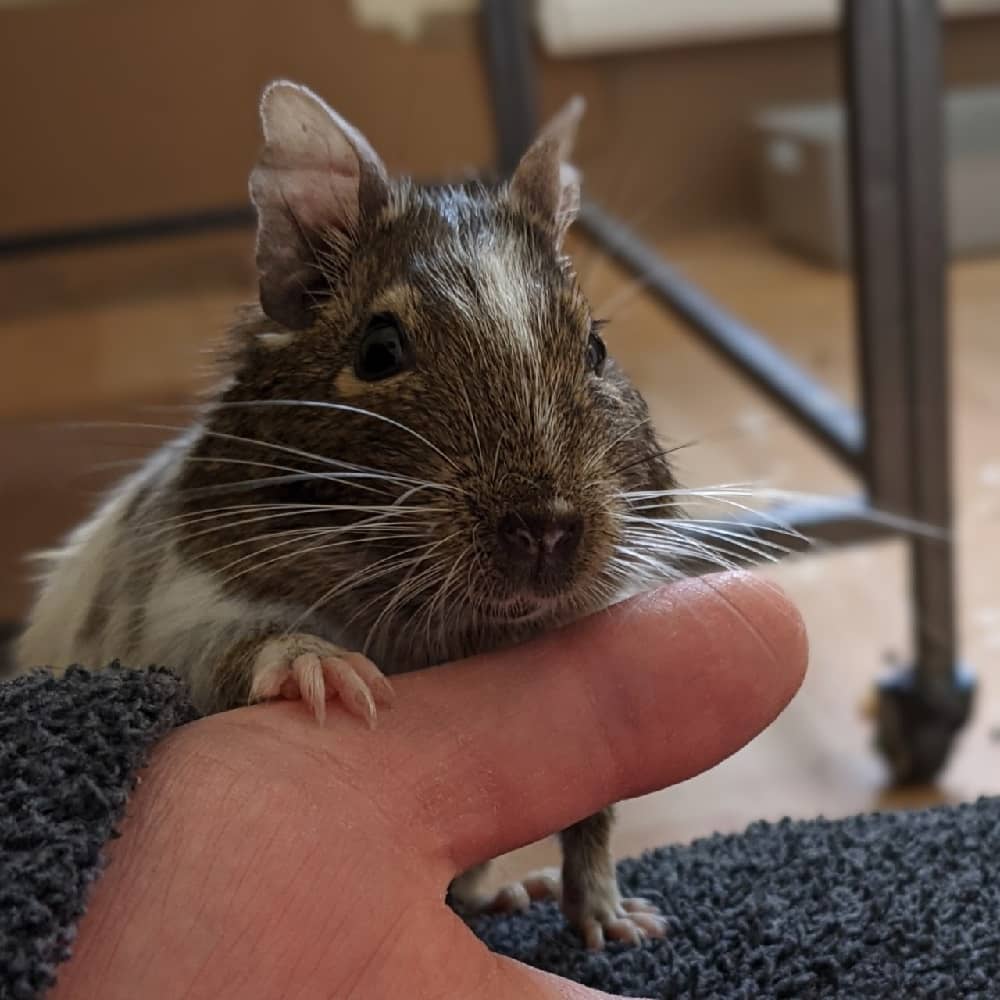
You should never try to catch a degu by its tail as it may exhibit an Antipredator mechanism of tail shedding. It is very painful for the degu and the tail never grows back. The degu may chew on the injured tail and get an infection.
You should always approach them calmly and avoid sudden movements. Support their body when picking them up and hold them close to your chest or on your lap, as they don’t like having their legs dangle. You should try to hold them gently as they may tend to bite if squeezed a little too hard.
Common Health Problems in Pet Degu
Common health issues in degus include dental problems, obesity, diabetes, and respiratory infections. If your Degu is alert with bright clear eyes, clean ears, glossy fur, a clean tail, and a clean anal area then these are indications of good health of your degu.
However, if you observe some of the symptoms then you should take your degu to the veterinarian.
- Discharge from nose
- Wetness around the mouth
- Opaque whitening of the eyes
- White teeth
The Concerned Health Issues Are
1. Diabetes
The degu can not process sugar and carbohydrates. Therefore a well-balanced diet is a must for degus. In severe conditions they can develop blindness also.
2.Bumble Foot:
Bumble foot is a very painful condition that causes red swelling and ulcers on the bottom of the Degu’s feet.
3. Mouth and Dental Problems:
Uneven incisor tooth wear, bruxism, pawing at the mouth, incapacity to gnaw, incisor tooth overgrowth (78.3%), and mobile molar teeth (4.3%) were among the clinical symptoms displayed by individual degus who were not yet officially diagnosed.
4.Skin Condition:
Skin disorders including dry skin, which can be avoided by giving your pet degu ,a frequent dust wash. Additionally keep a look out for pawing, trouble eating, and teary eyes. If any strange symptoms appear, get in touch with your exotics veterinarian.
Regular veterinary check-ups and a nutritious diet can help prevent many health problems.
Exercise
Regular exercise is essential for keeping your degu healthy and happy. Provide opportunities for your pet to run, jump, and play outside of their cage in a safe and supervised environment. Keeping a pair of degu is preferred over keeping a single degu as they enjoy running behind each other. Exercise wheels and toys designed for small rodents are also great options for keeping your degus active.
Grooming and Dental Care
The degus do not require any special grooming. They are self-groomed and maintenance-free pets. A sand bath is a great way to keep your degu clean entertainingly. However, if you find any dirt or debris in their paws, it can be easily cleaned with a wet wipe.
Teeth Trimming
The front teeth of degu keep on growing therefore chewy materials like wood chews, mineral chews, and chew tubes are a must in its habitat. Apart from that trimming from a vet is also needed at times
Nail Trimming
The nails of degu need to be trimmed either do it yourself else get it done through a veterinarian.
Upkeep Cost
The cost of caring for a degu includes expenses such as food, bedding, veterinary care, and occasional cage upgrades. On average, you may expect to spend around $20 to $30 per month on their upkeep.
Pros and Cons of Keeping Degu as a Pet
Pros:
- The degus are sociable and intelligent creatures therefore they make enjoyable companions. Their Diurnal nature aligns them well with human schedules as they are active during day.
- They enjoy interacting with their human caregivers.
- As low grooming is required and diet is also not so expensive as compared to other pets like dogs or cats, therefore upkeep cost is also low.
- These can be tamed at an early age. Their fascinating behaviors and vocalizations provide entertainment for owners.
Cons:
- Degus require a significant time investment for socialization and care.
- They can be prone to health problems if not provided with a proper diet and environment.
- Without social interactions, they may become aggressive and neurotic.
- They are voracious chewers so you may need to protect your wooden furniture.
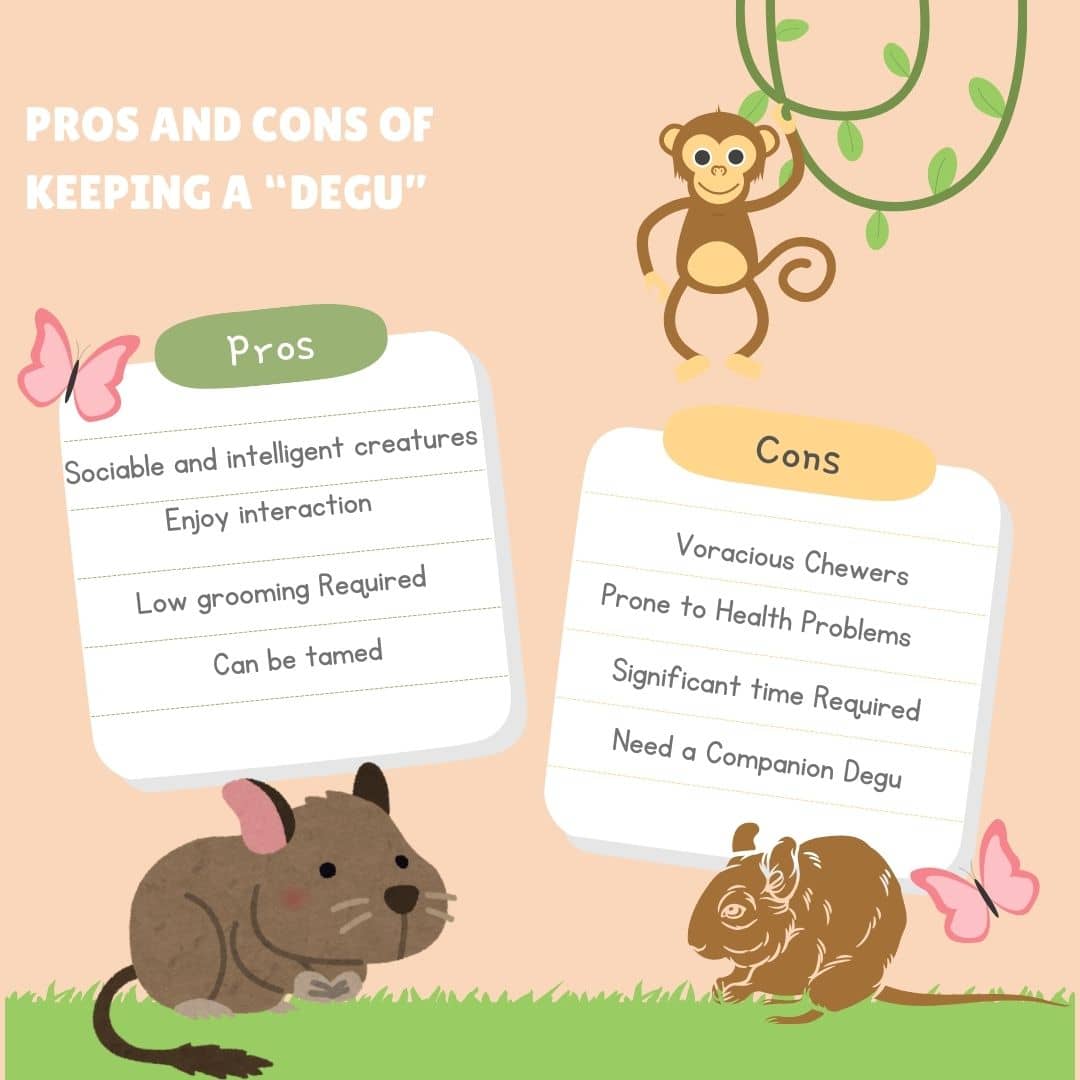
Where to Buy a Degu?
You can buy a degu from a local pet store or adopt it from a rescue team. Before proceeding to bring it to your home,you should enquire about its gender, age and well being. You can also check on these links for getting the degus.
- mammal pet: This online store has a wide range of healthy degus, guinea pigs and hamsters.
- Exotic Animals For Sale: This online store have baby degus available in agouti, pied agouti, creams, pied creams, blacks, pied blacks, non agouti blue, agouti blues, non agouti blue, chocolate, and lilac. There are individual pictures with pricing on their website.
The degus are the rodents with the longest gestation period of around 90 days. In the wild, the reproduction cycle is annual or biennial but in captivity it is shorter and the litters are often larger. The degus can have one to ten babies per litter but generally have on an average of 5-6 pups.

Similar Pets
- Chinchillas
- Gerbils
- Kinkajou
- Capybara
Frequently Asked Questions
Question1. Are degus good pets for children?
Answer: Degus can make great pets for responsible children under adult supervision. But with younger children, you should pay more attention.
Question2. Do degus like to be held or are they cuddly?
Answer: Degus are not cuddly pets like dogs and cats. However, they can be trained for human touch.
Question 3: Can degus be litter-trained?
Answer: It is impossible to potty-train these little creatures, with patience and consistency, degus can be confined to use a particular area to do their business as they use urine for scent-marking.
Question 4: Do Degus bite?
Answer: It is a rare phenomenon observed only when degu is under stress.
Question 5: Are Degus rare?
Answer: No, Degus are common and used in research
Question6: Are degus prone to any health problems?
Answer: Degus can be prone to dental problems, obesity, diabetes, and respiratory infections if not properly cared for.
Question7: Can Degus be housed with other small pets?
Answer: You should not keep small pets like hamster, guinea pigs and gerbil along with degu.
Question8: Does a Degu do better in their natural habitat?
Answer: Not necessarily ,in captivity, if they have access to a large exercise wheel and supervised playtime outside of their cage they do well.
Question9: How big does Degus get?
Answer: A degu is a small animal and get a size of nearly 25 cm.
Question 10: Are Degus low-maintenance?
Answer: The Degus are not low-maintenance as they need a continuous food supply and chewing material. These are prone to health problems, especially dental problems and need a visit to a veterinarian for trimming.
Fun Facts Of Degu
- The name Degu comes from the indigenous language of Chile, Mapudungum, and the word dewu means mouse or rat.
- Certain areas forbid the ownership of degus as pets.
- Because the shape of the degu’s teeth is similar to that of the number 8, the genus Octodon has been assigned to them.
- Degus digging together coordinates their activities forming digging chains. In the wild, degus live in complex burrow systems that they dig themselves.
- They have an elaborate vocal repertoire comprising up to 15 different sounds. They communicate using a variety of vocalizations, including chirps, squeaks, and barks.
- Degus have a keen sense of smell, which they use to navigate their environment and identify food sources.
- They have excellent eye and paw coordination. They have been observed stacking smaller things.
They can learn simple tricks. - They can discriminate UV light from the wavelength visible to humans.
- Degus has naturally yellow teeth and white teeth are a sign of ill health.
- Degus use their urine to scent mark their territories. Degus are highly territorial and will defend their territory from intruders.
- Degus recognize other degus and their owners by sight and sound and will often stand on hind legs to indicate their willingness to come out!!
- Degus are diurnal, which means that they are most active during the day.
- Degus have excellent hearing and can detect ultrasonic frequencies.
- They use their tails to communicate and interact with each other.
- Degus shed their tail’s skin and fur, therefore it acts as a protection mechanism to help them escape from predators.

